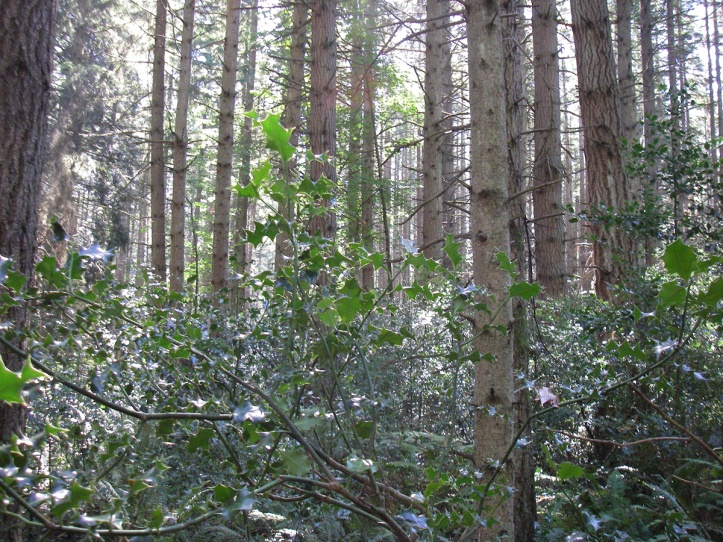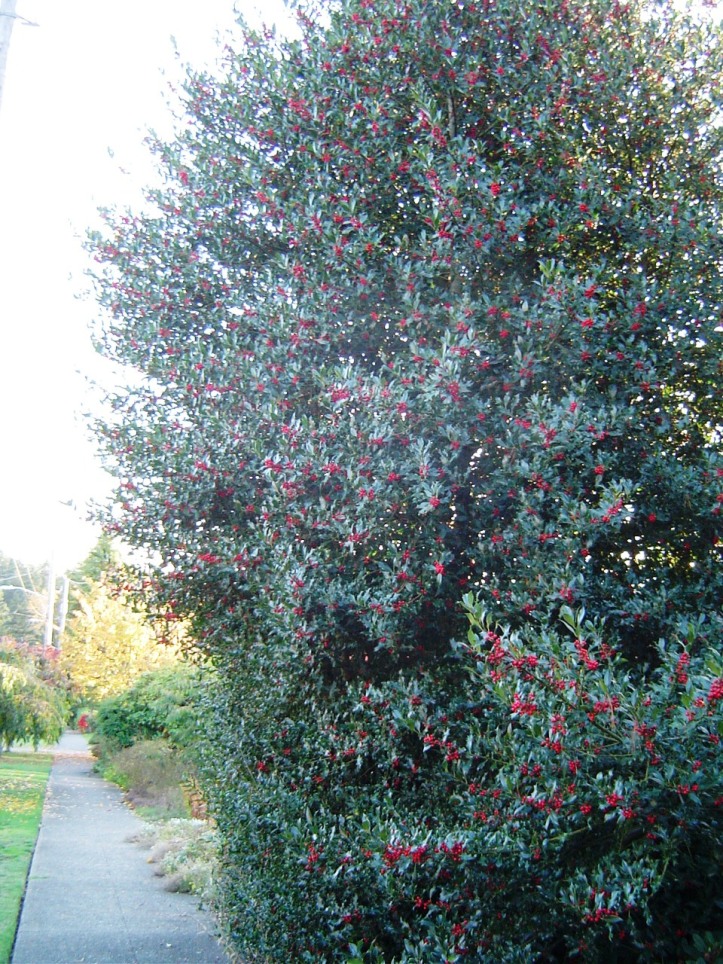
English holly’s red berries and beautiful, glossy green leaves evoke warm, holiday cheer for many. Unfortunately, we are also becoming all too familiar with seeing this plant along hiking trails and in out-of-the-way forests. Sadly, English holly is beginning to represent something much less warm and fuzzy than it used to, at least in this part of the world.

Although there is some debate about the level of threat posed by this popular European tree to the Pacific Northwest, there is clear evidence that English holly (Ilex aquifolium) is spreading well beyond where it is planted (with help from birds, of course) and is able to reproduce in the wild. According to the USDA distribution map, English holly is reported as naturalized in Washington, Oregon, California, and Hawaii, as well as Ontario and parts of Virginia and New Jersey.
According to the University of Washington Burke Herbarium records, botanists have collected specimens of English holly from naturalized populations in all 20 western Washington counties, including King County. There is clearly something about our climate that English holly thrives in, and our forests are definitely vulnerable to its establishment.
Collected plants have varied from immature plants to tall trees, and both male and female plants have been found. In some cases, the holly was growing as a single tree or in small, patchy populations, but in other cases, there were substantial populations noted that included a range of ages from seedlings to fruiting trees.
The locations of the collections also ranged from urban to rural, sometimes near where people probably planted it intentionally, but also in areas far from any intentional plantings, most likely brought there by birds. Many of the records indicate that English holly was naturalized at the site and growing with mostly native Washington forest species or a mix of native and non-native plants. It does appear that English holly is encroaching into native forest habitat and reproducing successfully in fairly undisturbed native communities.



The results of a research project on English holly at St. Edward State Park carried out by Dr. David Stokes and his students has shown there is some urgency for forests where holly is just starting to spread. The researchers found that although holly is slow to build up populations (it is an evergreen tree after all), it picks up speed alarmingly once it gets established in a forest. And the impacts to native forest plants are significant, with few plants able to grow under holly’s dense canopy. You can read more about the findings of that research project, along with other disturbing reports on holly, by checking out the presentations given at our 2014 English Holly Symposium.


In addition to its invasive tendencies, English holly is also challenging to control. From personal experience, digging up even a small holly tree is extremely labor-intensive and results in considerable soil disturbance. Using a pulling tool such as a Weed Wrench, Uprooter or Extractigator is super helpful for removing larger stems, but even those tools have their limits. (By the way, our program loans out weed pulling tools for free to people in King County – contact us for more info).


I don’t recommend simply cutting holly at the base since it re-sprouts from the crown, and spraying the foliage with herbicide is not very effective due to the thick, waxy leaves. For stems too large to pull or uproot with a tool, treating the trunk with an injection tool or the cut-stump method is much more effective, but requires a costly tool (the injection lance) or the ability to cut down a tree (safely!). Also, don’t leave uprooted holly stems on the ground, they are often able to form roots and continue to grow.
Of course the best approach is to find holly when the plants are still young and easier to dig up. Make sure not to confuse our native Oregon grape plants with small holly plants. Oregon grape only reaches shrub height but the leaves are holly-like so that can confuse people sometimes. There are a few species of Oregon grape all in the Genus Mahonia (formerly Berberis). See the UW Burke Museum image library for photos of all of them.


However, given holly’s ability to move deep into natural forests, this means that we all need to be on the lookout when we are out hiking or exploring. If we see a large population of holly or isolated plants growing deep inside natural areas, then we should contact the public agency managing that forest. Of course, given everyone’s limited resources, it may not be possible to remove the holly right away, but if resources do become available, knowing where to go to find these pioneering populations will be very important. Report English holly locations at https://www.eddmaps.org/west/ (report online or download their smart phone app) or in King County, use our online Report-a-Weed form.

Even though there’s no legal requirement to control English holly, many public agencies are beginning to control it where they have resources. The more information they have on locations, the better they can plan their work. And speaking of resources, most public agencies don’t have many staff for weed control, so they can always use volunteers. Check out our Volunteer Information page for suggestions on who to contact.
It is important to stress that English holly is produced and sold in Washington and Oregon and there are no regulations or limits on its sale or use in landscaping. In addition, English holly is not listed as a noxious weed in Washington or Oregon. In King County, we consider English holly to be a Weed of Concern. We recommend that it is removed as part of restoration projects and where it is encroaching into natural forests, but there is no requirement to do so.

For suggested alternatives to English Holly in landscaping, see the Garden Wise booklet, available for download or by contacting our office at 206-477-9333 or noxious.weeds@kingcounty.gov.
For more information on English holly, visit our website or download our English Holly Weed Alert.

Love that English holly is the December weed of the month!
Thanks!
English holly is just about the most shade-tolerant species in our forests, meaning that it can invade and persist even in intact conifer forests. On Vashon Island it is one of very few species (sometimes there’s some sword fern) that can be found in dense Douglas fir thickets, and seedlings and saplings populate our mature conifer and mixed forests.
English holly is tough! Thorough girdling should indeed kill the tops, in my experience nearly all of the trees I’ve girdled without other treatment have stump-sprouted below the girdle. So, while the individual tree is definitely set back in stature and reproductive capacity, it can recover and will be up to its old tricks at some point in the future.
Why isn’t this classified as an invasive? I have encountered and battled English holly in Seattle’s urban forest land for years and it is one tough, resourceful adversary. Holly’s remarkably plastic morphology allows it to grow as a tree, shrub, or essentially a vine, especially in low light, competitive environments. Seattle’s green belts are chock full of holly. Dead holly leaves are pure misery. Putting the species on the invasives list can only help.
Thank you for your comment and your passion! I agree completely! In King County, we definitely consider English holly to be an invasive plant and that’s why it’s on the King County Weeds of Concern list. For it to be put on the State Noxious Weed List, the State Weed Board would need to vote for that. They review proposals for noxious weed list changes every year and accept proposals from January to April (For more information see https://www.nwcb.wa.gov/get-involved) . They weigh the negative impacts of plants against the positive or commercial benefits and up to this point they have determined that the benefits of holly have outweighed the negative impacts. Thank you for battling English holly! It’s going to take many more people like you but I think we have hope because of wonderful volunteers like yourself!
I love English Holly, and defend it, as some of you are aware. On our farm it protected generations of doves, since racoons and other predators have difficulty climbing to bird nests through the prickly branches. Also, like the Himalayan blackberry – it is too late to effectively control! Please do not waste valuable King County weed control resources attempting to control an established and festive evergreen that provides beautiful red berries that nourish wildlife. There is just a hint of discrimination involved in the ‘get the Holly’ crusade if you are willing to recognize that the introduced European cherry is many times more prevalent in our forests close to civilization and, like the Holly, is spread by birds and cannot be effectively controlled! However, it is pretty and we like to eat the fruit – so we ‘forgive’ its very successful invasion. I am not suggesting that introduced European cherry be on anyone’s weed list – but see discrimination in what we choose to control.
I am having success girdling holly trees. They take a while to die completely, but they stop making berries immediately, and they don’t send up lots of shoots like they do when you cut them down. And the best part is that no one is exposed to toxic pesticides.
I’m glad to hear girdling is working for you!